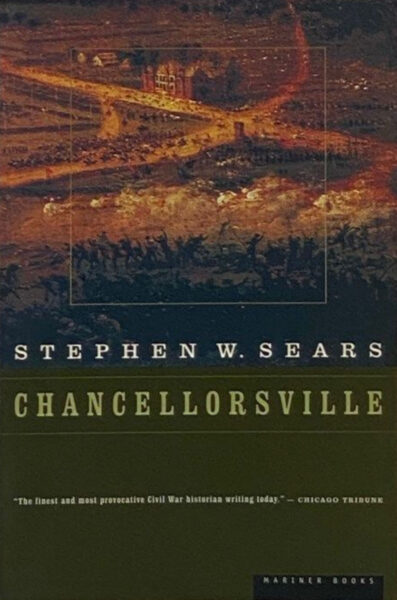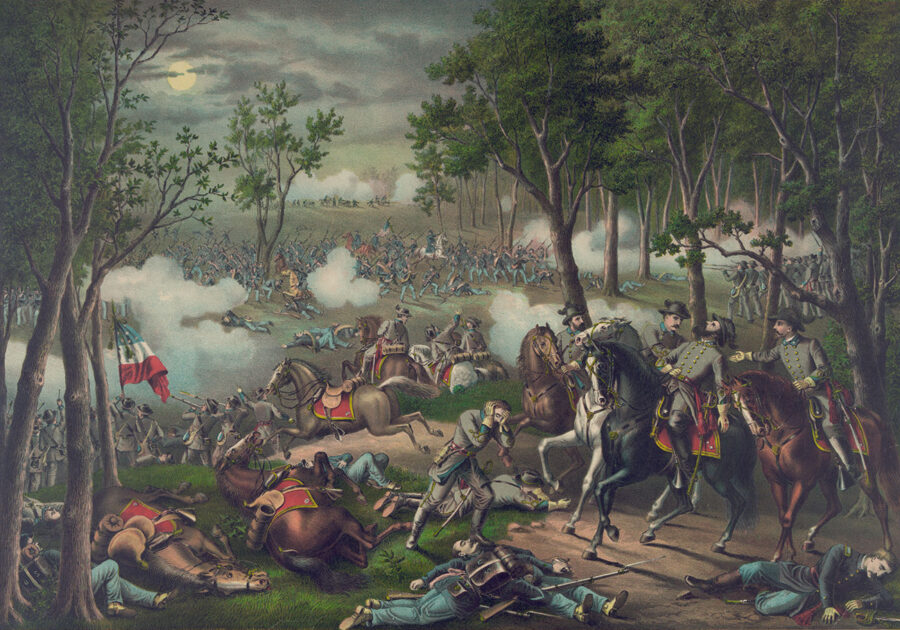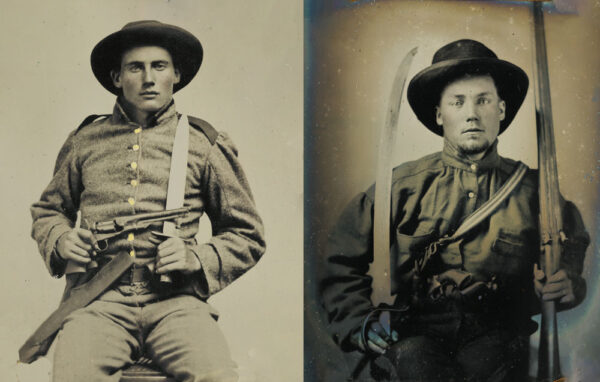Sometimes a battle begets book upon book. Gettysburg? Rent a truck before you go shopping. There might be more books on Gettysburg than there were soldiers in Pickett’s Charge. Antietam is in the midst of a mini-boom of new studies, some of them excellent. First Manassas has prompted almost rhythmic retellings over the last six decades.

“Sears writes smartly and always with a viewpoint.”
Chancellorsville? You could fit most of the books written about Chancellorsville in a beach bag. Chancellorsville—fought April 30 to May 6, 1863, at Spotsylvania County, Virginia—has lived a relatively quiet historiographical life. Historians and the public like beginnings, turning points, conclusions, and simplicity, and Chancellorsville offers none of these. Immensely complicated and fought mostly in the woods, its participants had but a dim notion, if that, of what went on around them. Union general A.A. Humphreys admitted he knew “less in regard to … Chancellorsville than any other battle I ever took part in.”
But Chancellorsville had Robert E. Lee and Thomas J. “Stonewall” Jackson at the top of their game, arrayed against twice their numbers under the command of the much-debated Joseph Hooker. While the list of books on Chancellorsville is not long, the battle’s historiography is thoughtful, efficient (gratefully), and even compelling. A summer with your beach bag will land you in the 99.9th percentile among people who know something of Chancellorsville. And along the way, you would experience firsthand how Civil War scholarship has evolved.
Many Civil War campaigns have that foundational book from which all else grows. Edwin Coddington’s Gettysburg (1968), Edward Steere’s The Wilderness Campaign (1960), and Frank O’Reilly’s Fredericksburg (2003) are good examples. Chancellorsville has the ancestor of all those works, the 1910 volume by John Bigelow, The Campaign of Chancellorsville: A Strategic and Tactical Study.
 Library of Congress
Library of CongressThis postwar chromolithograph by Kurz & Allison depicts Confederate General Thomas J. “Stonewall” Jackson’s wounding at the Battle of Chancellorsville.
Bigelow was a West Point graduate who taught military science and tactics at Massachusetts Institute of Technology in the 1890s. To him, Chancellorsville “presented a greater variety of military problems and experiences” than any American battle. He tackled those in a behemoth of a book—more than 528 oversized pages and 47 detailed, fold-out colored maps that make this work unique in the annals of Civil War campaign histories. When I came into the history business in the early 1980s, owning a copy of Bigelow ($1,000-plus), or even the 1984 Morningside reprint (at $200), was a nerdish status symbol.
Widely acclaimed as rigorous, fair, and dense (“primarily intended for the army officer and the historical student,” wrote an astute early reviewer), The Campaign of Chancellorsville established an essential narrative of the battle, located major events on the landscape, and set the contours of debate about the actions of its major players. Over time, Bigelow’s version of Chancellorsville became conventional wisdom: effusive praise for Lee and Jackson; applause for Hooker’s rehabilitation of the Army of the Potomac in early 1863; criticism of his performance on the field. Consciously or not, everyone who has since written about Chancellorsville has built upon or modified Bigelow’s work.
If you mean to read more than one book about Chancellorsville, start with Ernest Furgurson’s 1992 Chancellorsville: Souls of the Brave. For depth and revelation, it has been surpassed, but not for its narrative elegance. Some of the most-read books on the Civil War have come from journalists—think of Douglas Southall Freeman, Bruce Catton, Glenn Tucker, Clifford Dowdy, and now Furgurson, a longtime correspondent and columnist for the Baltimore Sun. He breaks little new historical ground (and he accepts uncritically a few tropes), but he has given us a solid Chancellorsville book that continues that readable tradition of reporters-turned-historians.
The loud voice in the Chancellorsville room these days is that of Stephen Sears, perhaps our generation’s greatest historian of the war in the East in 1862–1863. Sears writes smartly and always with a viewpoint, grinding away at his foil (usually George McClellan) or rehabilitating someone else’s. His 1996 book, Chancellorsville, is, among other things, a historiographical lifeboat for Hooker. In many ways, Sears is the anti-Bigelow.
In explaining Union defeat, Sears fingers subordinate generals whom Hooker blamed: John Sedgwick, Oliver Otis Howard, Daniel Sickles, and George Stoneman. Sears also assails the traditional argument that Hooker “lost his nerve” on May 1. He paints Lee and Jackson not just as bold, but perhaps even reckless (an opinion, not surprisingly, shared by Hooker). According to Hooker and Sears, the Confederate gambit on May 2—in which Lee divided his army and sent Jackson’s corps on an attack around the Union right flank—succeeded largely due to the failures of Hooker’s subordinates, not Confederate brilliance. To Sears’ great credit, he gives proper space to the decisive fighting on the morning of May 3—a horrific morning of combat that saw 18,000 casualties in five hours. And he includes groundbreaking research on the work of the new Union intelligence bureau during the campaign. Though some of Sears’ conclusions about Chancellorsville may be debatable, this book is deeply researched and considered—perhaps the most diligent of his four campaign studies. It stands as the best book to date on the Chancellorsville Campaign.
Chancellorsville produced two stories that lived well beyond battle’s end. Each has a book well worth reading. Christian Keller’s Chancellorsville and the Germans will not only tell you much about Chancellorsville, but also makes larger points about the war and 19th-century America. The Union XI Corps included most of the army’s German-speaking soldiers. On May 2, it suffered the direct impact of Jackson’s famous flank attack, and retreated in some disorder. Though many of its units stood and fought bravely, the XI Corps at large became the army’s explanation for defeat. The idea that the Germans simply ran at Chancellorsville lives in memory. Keller’s book is a powerful antidote to that xenophobic trope and an insightful look at a complicated and fascinating unit, the XI Corps.
We’ve remarkably arrived at 900-plus words on this historiographical journey without mentioning Chancellorsville’s most famous and most written-about event: the wounding and death of Stonewall Jackson. Who shot him? His own men? Where did he fall? Why did he die? These questions have undergone NCIS-level analysis at the hands of historians. In Gary Gallagher’s excellent 1996 volume of essays, Chancellorsville: The Battle and its Aftermath, former National Park Service Historian Robert Krick (in “The Smoothbore Volley That Doomed the Confederacy”) recounted the evidence surrounding Jackson’s wounding in fascinating, near-forensic detail. He concluded precisely where Jackson was wounded and where he was lowered from his horse. You will leave his essay thinking, “That makes perfect sense.” You might also wonder why the details matter that much—an interesting question in itself. The NPS, by the way, largely abides Krick’s conclusions in its treatment of the site.
In 2013, Matthew Lively, a physician, laid before us Calamity at Chancellorsville: The Wounding and Death of Confederate General Stonewall Jackson. Lively applies both his medical knowledge and some astute historiography chops to the topic. As for the site of Jackson’s wounding, he comes to a different conclusion from Krick’s. When you read Lively’s account, again you will finish it thinking, “That makes perfect sense” (such is history sometimes). But the bulk of the book examines Jackson’s care, his transport to Guinea Station, his slow slide toward death, and its aftermath. Lively uses virtually every known account of Jackson’s final days, and his narrative stands unequalled. It is detailed without being gratuitous, vivid without being sentimental.

Crane focused on the feeling of combat and what he saw as its inevitable results: human failure or human virtue.
The last Chancellorsville-related book to read is by a wide margin the greatest of them all: Stephen Crane’s The Red Badge of Courage (1895). Most of us probably remember it for the irksome book report we had to write in school. In 2005, I picked up Red Badge again, armed with a little life experience and a bookish knowledge of the lived ordeal of Civil War soldiers. It staggered me. The prose and imagery are exquisite. Crane’s insights into human nature are profound (more so because he was only 24 when he wrote it).
The Red Badge of Courage is, Crane later tells us, set in the forests of Chancellorsville, but it is not about Chancellorsville. It is predominantly “a psychological portrayal of fear,” as Crane himself put it. It was, 30 years on, a corrective (and challenge) to the anodyne soldiers’ memoirs then flooding the market—interesting and useful books that focused on the physical experience of war. Crane focused on the feeling of combat and what he saw as its inevitable results: human failure or human virtue. If you have never read it, do so. If you only read it as a young student, reread it. Then take it, put it in the bag with your other books, and head to Chancellorsville for a walk in its woods.
John Hennessy retired as the Chief Historian at Fredericksburg and Spotsylvania National Military Park. He is the author of dozens of articles and four books, including Return to Bull Run: the Campaign and Battle of Second Manassas (Simon & Schuster, 1993; reprint edition, 1999, by University of Oklahoma Press).




